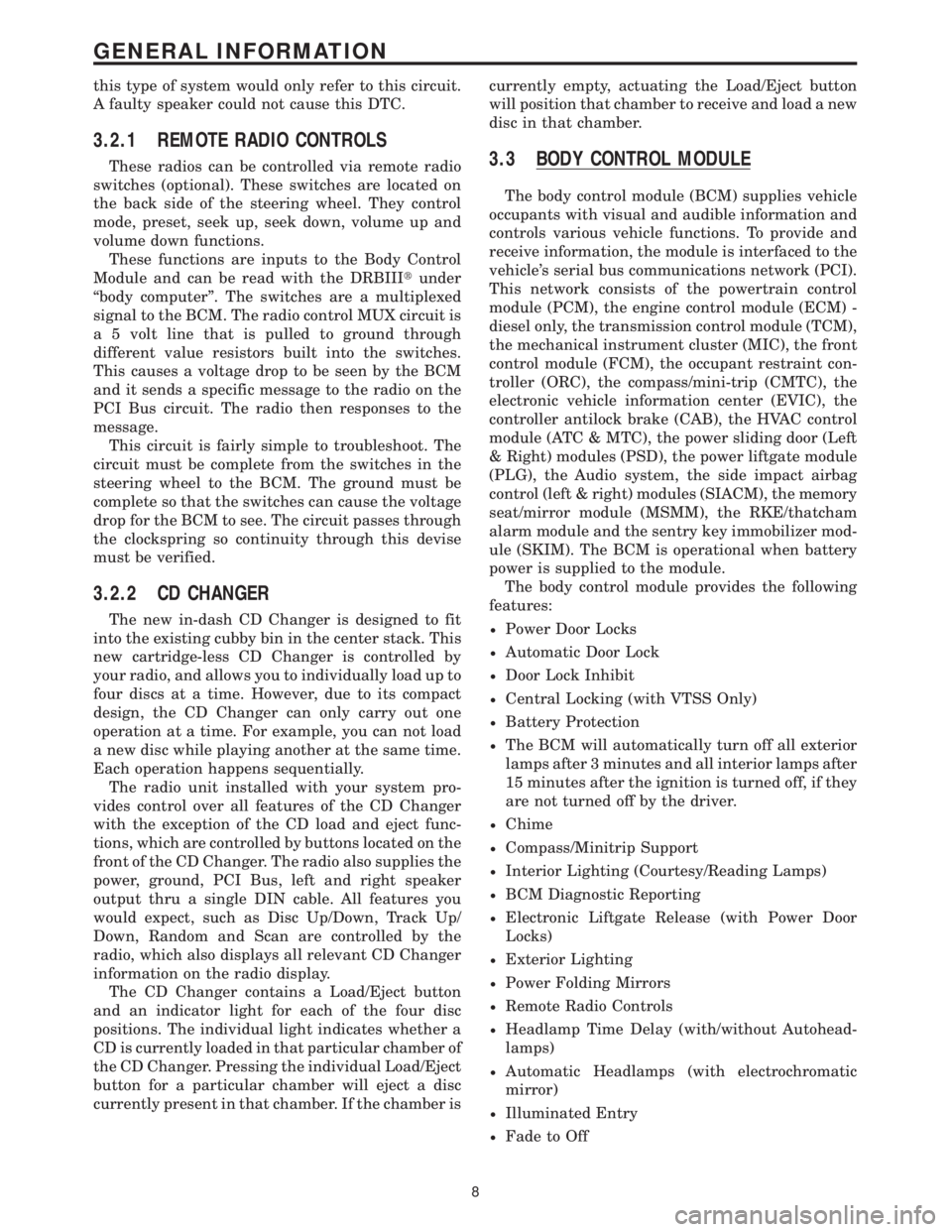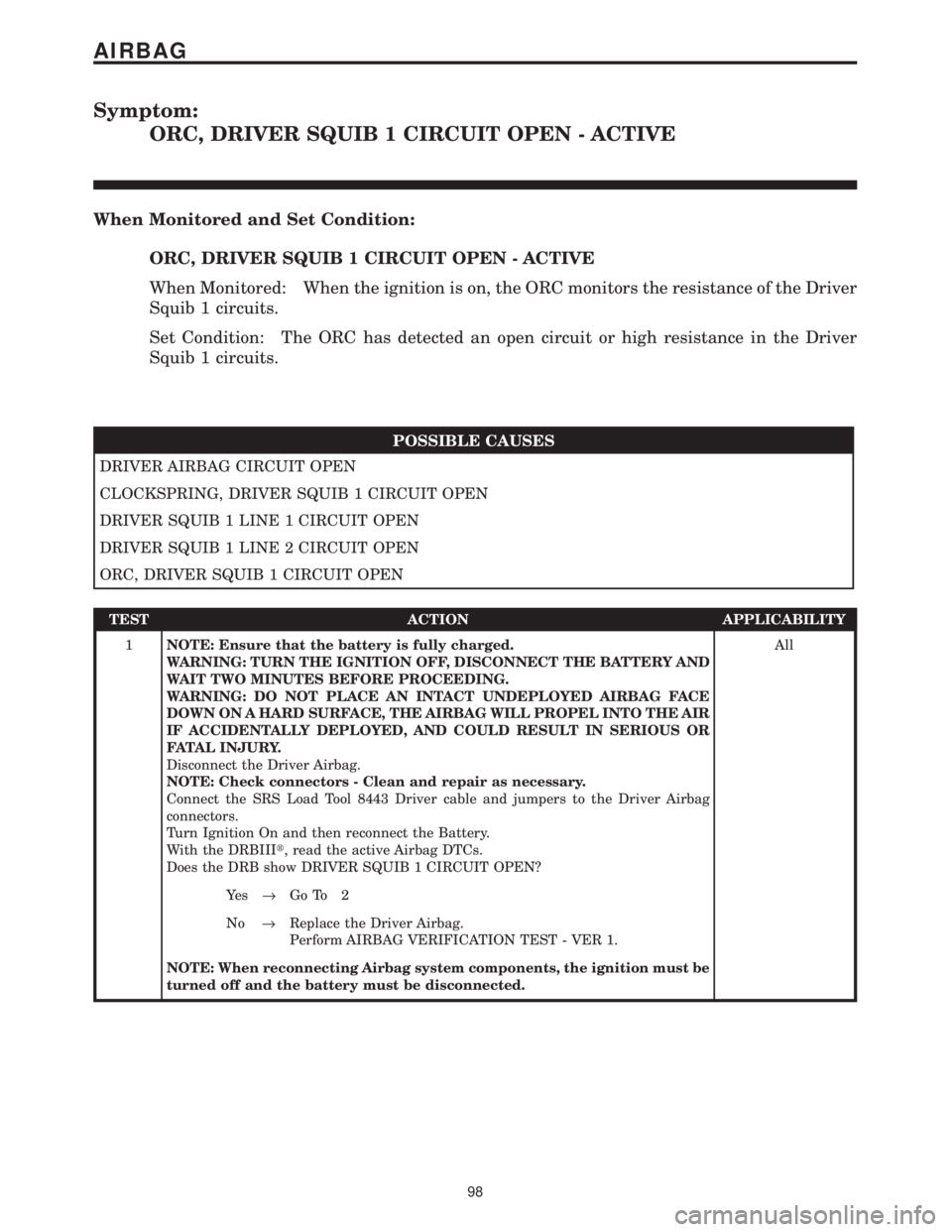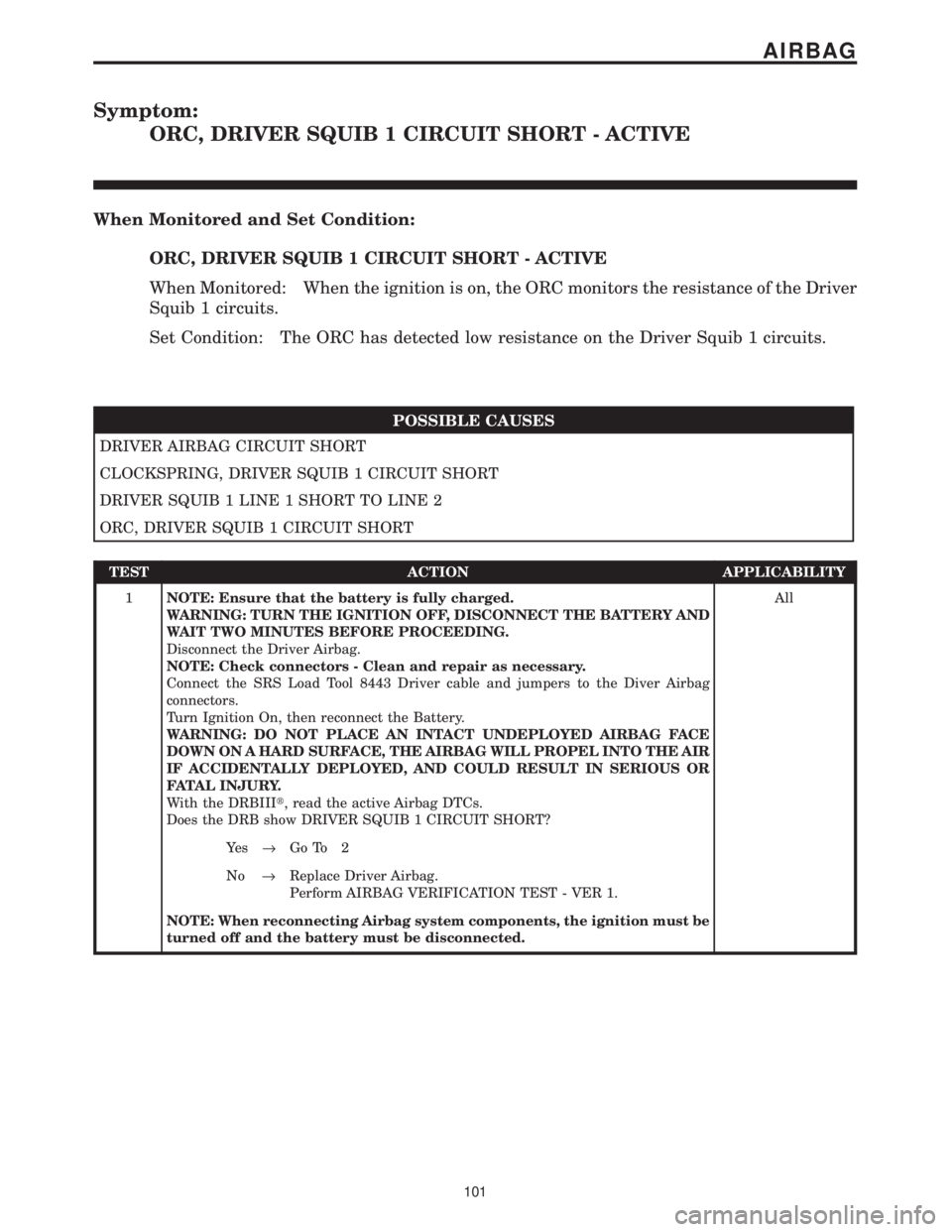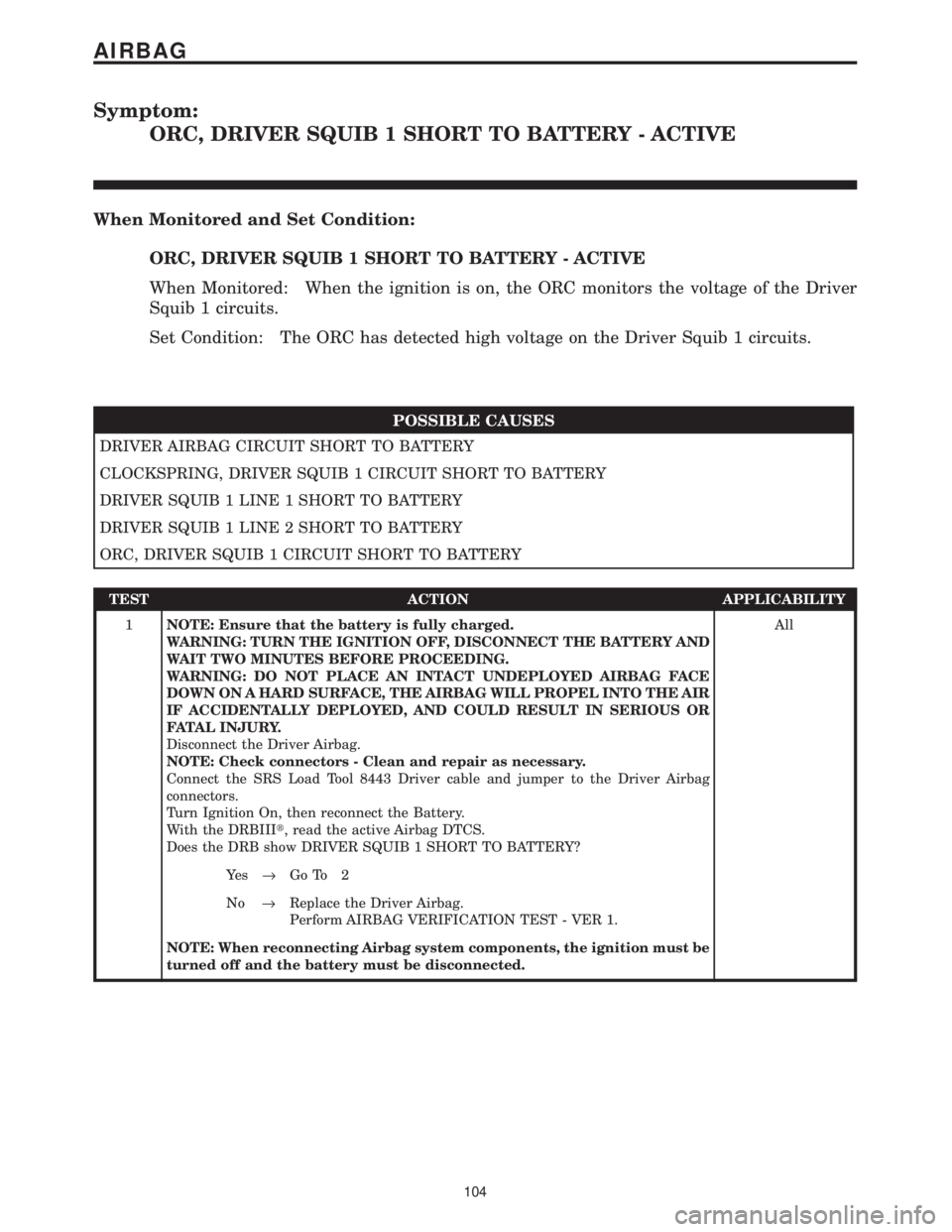set clock CHRYSLER VOYAGER 2001 Service Manual
[x] Cancel search | Manufacturer: CHRYSLER, Model Year: 2001, Model line: VOYAGER, Model: CHRYSLER VOYAGER 2001Pages: 4284, PDF Size: 83.53 MB
Page 31 of 4284

mitted on the bus even though a module may not
require all information to perform its function. It
will only respond to messages ªaddressedº to it
through binary coding process. This method of data
transmission significantly reduces the complexity
of the wiring in the vehicle and the size of wiring
harnesses. All of the information about the func-
tioning of all the systems is organized, controlled,
and communicated by the PCI bus, which is de-
scribed in the Communication Section of this gen-
eral information.
3.1 AIRBAG SYSTEM/OCCUPANT
RESTRAINT CONTROLLER SYSTEM
The 2001 Minivan Airbag System contain the
following components: Occupant Restraint Control-
ler (ORC), Airbag Warning Indicator, Clockspring,
Driver and Passenger Airbags, Seat belt Tensioners
(SBT), Hall-effect Seat Belt Switches (SBS), Left
and Right Side Airbag Control Module (SIACM),
and Seat (mounted side) Airbags.
The Occupant Restraint Controller (ORC) is a
new type of Airbag Control Module (ACM) that
supports staged airbag deployment. Staged deploy-
ment is the ability to trigger airbag system squib
inflators all at once or individually as needed to
provide the appropriate restraint for the severity of
the impact. The ORC has four major functions: PCI
Bus communications, onboard diagnostics, impact
sensing, and component deployment. The ORC also
contains an energy-storage capacitor. This capaci-
tor stores enough electrical energy to deploy the
front airbag components for two seconds following a
battery disconnect or failure during an impact. The
ORC is secured to the floor panel transmission
tunnel below the instrument panel inside the vehi-
cle. The ORC cannot be repaired or adjusted and
must be replaced.
The ORC sends and/or receives PCI Bus mes-
sages with the Instrument Cluster (MIC), Body
Control Module (BCM), and Powertrain Control
Module (PCM). Diagnostic trouble codes will be set
if the communication with these modules is lost or
contains invalid information.
The microprocessor in the ORC monitors the
impact sensor signal and the airbag system electri-
cal circuits to determine the system readiness. The
ORC also monitors bus messages from both SIACM.
If the ORC detects a monitored system fault or
SIACM fault, it sends a message to the instrument
cluster via PCI bus to turn on the airbag warning
indicator. The ORC can set both active and stored
diagnostic trouble codes to aid in the diagnosing
system problems. See ORC/SIACM DIAGNOSTIC
TROUBLE CODES in this section.
The ORC has an internal accelerometer that
senses the rate of vehicle deceleration, which pro-vides verification of the direction and severity of an
impact. A pre-programmed decision algorithm in
the ORC microprocessor determines when the de-
celeration rate is severe enough to require airbag
system protection. The Occupant Restraint Control-
ler (ORC) also uses the driver and front passenger
seat belt switch status (buckled or unbuckled) as
inputs to determine the level of airbag deployment,
low, medium, or high as well as whether or not the
seat belt tensioners should deploy. The ORC also
uses the crash severity to determine the level of
driver and front passenger deployment, low me-
dium or high. When the programmed conditions are
met, the ORC sends an electrical signal to deploy
the appropriate airbag system components.WARNING: THE AIRBAG SYSTEM IS A
SENSITIVE, COMPLEX ELECTRO-
MECHANICAL UNIT. BEFORE ATTEMPTING
TO DIAGNOSE OR SERVICE ANY AIRBAG
SYSTEM OR RELATED STEERING WHEEL,
STEERING COLUMN, OR INSTRUMENT
PANEL COMPONENTS YOU MUST FIRST
DISCONNECT AND ISOLATE THE BATTERY
NEGATIVE (GROUND) CABLE. WAIT TWO
MINUTES FOR THE SYSTEM CAPACITOR TO
DISCHARGE BEFORE FURTHER SYSTEM
SERVICE. THIS IS THE ONLY SURE WAY TO
DISABLE THE AIRBAG SYSTEM. FAILURE
TO DO THIS COULD RESULT IS ACCIDENTAL
AIRBAG DEPLOYMENT AND POSSIBLE
PERSONAL INJURY. NEVER STRIKE OR
KICK THE AIRBAG CONTROL MODULE, AS
IT CAN DAMAGE THE IMPACT SENSOR OR
AFFECT ITS CALIBRATION. IF AN AIRBAG
CONTROL MODULE IS ACCIDENTALLY
DROPPED DURING SERVICE, THE MODULE
MUST BE SCRAPPED AND REPLACED WITH
A NEW UNIT.
The airbag warning lamp is the only point at
which the customer can observe symptoms of a
system malfunction. Whenever the ignition key is
turned to the run or start position, the MIC per-
forms a lamp check by turning the airbag warning
indicator on for 6-8 seconds. After the lamp check, if
the indicator turns on, it means that the ORC has
checked the system and found it to be free of
discernible malfunctions. If the lamp remains on,
there could be an active fault in the system or the
MIC lamp circuit may be internally shorted to
ground. If the lamp comes on and stays on for a
period longer than 6-8 seconds then goes off, there
is usually an intermittent problem in the system.
2
GENERAL INFORMATION
Page 37 of 4284

this type of system would only refer to this circuit.
A faulty speaker could not cause this DTC.
3.2.1 REMOTE RADIO CONTROLS
These radios can be controlled via remote radio
switches (optional). These switches are located on
the back side of the steering wheel. They control
mode, preset, seek up, seek down, volume up and
volume down functions.
These functions are inputs to the Body Control
Module and can be read with the DRBIIItunder
ªbody computerº. The switches are a multiplexed
signal to the BCM. The radio control MUX circuit is
a 5 volt line that is pulled to ground through
different value resistors built into the switches.
This causes a voltage drop to be seen by the BCM
and it sends a specific message to the radio on the
PCI Bus circuit. The radio then responses to the
message.
This circuit is fairly simple to troubleshoot. The
circuit must be complete from the switches in the
steering wheel to the BCM. The ground must be
complete so that the switches can cause the voltage
drop for the BCM to see. The circuit passes through
the clockspring so continuity through this devise
must be verified.
3.2.2 CD CHANGER
The new in-dash CD Changer is designed to fit
into the existing cubby bin in the center stack. This
new cartridge-less CD Changer is controlled by
your radio, and allows you to individually load up to
four discs at a time. However, due to its compact
design, the CD Changer can only carry out one
operation at a time. For example, you can not load
a new disc while playing another at the same time.
Each operation happens sequentially.
The radio unit installed with your system pro-
vides control over all features of the CD Changer
with the exception of the CD load and eject func-
tions, which are controlled by buttons located on the
front of the CD Changer. The radio also supplies the
power, ground, PCI Bus, left and right speaker
output thru a single DIN cable. All features you
would expect, such as Disc Up/Down, Track Up/
Down, Random and Scan are controlled by the
radio, which also displays all relevant CD Changer
information on the radio display.
The CD Changer contains a Load/Eject button
and an indicator light for each of the four disc
positions. The individual light indicates whether a
CD is currently loaded in that particular chamber of
the CD Changer. Pressing the individual Load/Eject
button for a particular chamber will eject a disc
currently present in that chamber. If the chamber iscurrently empty, actuating the Load/Eject button
will position that chamber to receive and load a new
disc in that chamber.
3.3 BODY CONTROL MODULE
The body control module (BCM) supplies vehicle
occupants with visual and audible information and
controls various vehicle functions. To provide and
receive information, the module is interfaced to the
vehicle's serial bus communications network (PCI).
This network consists of the powertrain control
module (PCM), the engine control module (ECM) -
diesel only, the transmission control module (TCM),
the mechanical instrument cluster (MIC), the front
control module (FCM), the occupant restraint con-
troller (ORC), the compass/mini-trip (CMTC), the
electronic vehicle information center (EVIC), the
controller antilock brake (CAB), the HVAC control
module (ATC & MTC), the power sliding door (Left
& Right) modules (PSD), the power liftgate module
(PLG), the Audio system, the side impact airbag
control (left & right) modules (SIACM), the memory
seat/mirror module (MSMM), the RKE/thatcham
alarm module and the sentry key immobilizer mod-
ule (SKIM). The BCM is operational when battery
power is supplied to the module.
The body control module provides the following
features:
²Power Door Locks
²Automatic Door Lock
²Door Lock Inhibit
²Central Locking (with VTSS Only)
²Battery Protection
²The BCM will automatically turn off all exterior
lamps after 3 minutes and all interior lamps after
15 minutes after the ignition is turned off, if they
are not turned off by the driver.
²Chime
²Compass/Minitrip Support
²Interior Lighting (Courtesy/Reading Lamps)
²BCM Diagnostic Reporting
²Electronic Liftgate Release (with Power Door
Locks)
²Exterior Lighting
²Power Folding Mirrors
²Remote Radio Controls
²Headlamp Time Delay (with/without Autohead-
lamps)
²Automatic Headlamps (with electrochromatic
mirror)
²Illuminated Entry
²Fade to Off
8
GENERAL INFORMATION
Page 127 of 4284

Symptom:
ORC, DRIVER SQUIB 1 CIRCUIT OPEN - ACTIVE
When Monitored and Set Condition:
ORC, DRIVER SQUIB 1 CIRCUIT OPEN - ACTIVE
When Monitored: When the ignition is on, the ORC monitors the resistance of the Driver
Squib 1 circuits.
Set Condition: The ORC has detected an open circuit or high resistance in the Driver
Squib 1 circuits.
POSSIBLE CAUSES
DRIVER AIRBAG CIRCUIT OPEN
CLOCKSPRING, DRIVER SQUIB 1 CIRCUIT OPEN
DRIVER SQUIB 1 LINE 1 CIRCUIT OPEN
DRIVER SQUIB 1 LINE 2 CIRCUIT OPEN
ORC, DRIVER SQUIB 1 CIRCUIT OPEN
TEST ACTION APPLICABILITY
1NOTE: Ensure that the battery is fully charged.
WARNING: TURN THE IGNITION OFF, DISCONNECT THE BATTERY AND
WAIT TWO MINUTES BEFORE PROCEEDING.
WARNING: DO NOT PLACE AN INTACT UNDEPLOYED AIRBAG FACE
DOWN ON A HARD SURFACE, THE AIRBAG WILL PROPEL INTO THE AIR
IF ACCIDENTALLY DEPLOYED, AND COULD RESULT IN SERIOUS OR
FATAL INJURY.
Disconnect the Driver Airbag.
NOTE: Check connectors - Clean and repair as necessary.
Connect the SRS Load Tool 8443 Driver cable and jumpers to the Driver Airbag
connectors.
Turn Ignition On and then reconnect the Battery.
With the DRBIIIt, read the active Airbag DTCs.
Does the DRB show DRIVER SQUIB 1 CIRCUIT OPEN?All
Ye s®Go To 2
No®Replace the Driver Airbag.
Perform AIRBAG VERIFICATION TEST - VER 1.
NOTE: When reconnecting Airbag system components, the ignition must be
turned off and the battery must be disconnected.
98
AIRBAG
Page 130 of 4284

Symptom:
ORC, DRIVER SQUIB 1 CIRCUIT SHORT - ACTIVE
When Monitored and Set Condition:
ORC, DRIVER SQUIB 1 CIRCUIT SHORT - ACTIVE
When Monitored: When the ignition is on, the ORC monitors the resistance of the Driver
Squib 1 circuits.
Set Condition: The ORC has detected low resistance on the Driver Squib 1 circuits.
POSSIBLE CAUSES
DRIVER AIRBAG CIRCUIT SHORT
CLOCKSPRING, DRIVER SQUIB 1 CIRCUIT SHORT
DRIVER SQUIB 1 LINE 1 SHORT TO LINE 2
ORC, DRIVER SQUIB 1 CIRCUIT SHORT
TEST ACTION APPLICABILITY
1NOTE: Ensure that the battery is fully charged.
WARNING: TURN THE IGNITION OFF, DISCONNECT THE BATTERY AND
WAIT TWO MINUTES BEFORE PROCEEDING.
Disconnect the Driver Airbag.
NOTE: Check connectors - Clean and repair as necessary.
Connect the SRS Load Tool 8443 Driver cable and jumpers to the Diver Airbag
connectors.
Turn Ignition On, then reconnect the Battery.
WARNING: DO NOT PLACE AN INTACT UNDEPLOYED AIRBAG FACE
DOWN ON A HARD SURFACE, THE AIRBAG WILL PROPEL INTO THE AIR
IF ACCIDENTALLY DEPLOYED, AND COULD RESULT IN SERIOUS OR
FATAL INJURY.
With the DRBIIIt, read the active Airbag DTCs.
Does the DRB show DRIVER SQUIB 1 CIRCUIT SHORT?All
Ye s®Go To 2
No®Replace Driver Airbag.
Perform AIRBAG VERIFICATION TEST - VER 1.
NOTE: When reconnecting Airbag system components, the ignition must be
turned off and the battery must be disconnected.
101
AIRBAG
Page 133 of 4284

Symptom:
ORC, DRIVER SQUIB 1 SHORT TO BATTERY - ACTIVE
When Monitored and Set Condition:
ORC, DRIVER SQUIB 1 SHORT TO BATTERY - ACTIVE
When Monitored: When the ignition is on, the ORC monitors the voltage of the Driver
Squib 1 circuits.
Set Condition: The ORC has detected high voltage on the Driver Squib 1 circuits.
POSSIBLE CAUSES
DRIVER AIRBAG CIRCUIT SHORT TO BATTERY
CLOCKSPRING, DRIVER SQUIB 1 CIRCUIT SHORT TO BATTERY
DRIVER SQUIB 1 LINE 1 SHORT TO BATTERY
DRIVER SQUIB 1 LINE 2 SHORT TO BATTERY
ORC, DRIVER SQUIB 1 CIRCUIT SHORT TO BATTERY
TEST ACTION APPLICABILITY
1NOTE: Ensure that the battery is fully charged.
WARNING: TURN THE IGNITION OFF, DISCONNECT THE BATTERY AND
WAIT TWO MINUTES BEFORE PROCEEDING.
WARNING: DO NOT PLACE AN INTACT UNDEPLOYED AIRBAG FACE
DOWN ON A HARD SURFACE, THE AIRBAG WILL PROPEL INTO THE AIR
IF ACCIDENTALLY DEPLOYED, AND COULD RESULT IN SERIOUS OR
FATAL INJURY.
Disconnect the Driver Airbag.
NOTE: Check connectors - Clean and repair as necessary.
Connect the SRS Load Tool 8443 Driver cable and jumper to the Driver Airbag
connectors.
Turn Ignition On, then reconnect the Battery.
With the DRBIIIt, read the active Airbag DTCS.
Does the DRB show DRIVER SQUIB 1 SHORT TO BATTERY?All
Ye s®Go To 2
No®Replace the Driver Airbag.
Perform AIRBAG VERIFICATION TEST - VER 1.
NOTE: When reconnecting Airbag system components, the ignition must be
turned off and the battery must be disconnected.
104
AIRBAG
Page 136 of 4284

Symptom:
ORC, DRIVER SQUIB 1 SHORT TO GROUND - ACTIVE
When Monitored and Set Condition:
ORC, DRIVER SQUIB 1 SHORT TO GROUND - ACTIVE
When Monitored: When the ignition is on, the ORC monitors the resistance of the Driver
Squib 1 circuits.
Set Condition: The ORC has detected a short to ground in the Driver Squib 1 circuits.
POSSIBLE CAUSES
DRIVER AIRBAG CIRCUIT SHORT TO GROUND
CLOCKSPRING, DRIVER SQUIB 1 CIRCUIT SHORT TO GROUND
DRIVER SQUIB 1 LINE 1 SHORT TO GROUND
DRIVER SQUIB 1 LINE 2 SHORT TO GROUND
ORC, DRIVER SQUIB 1 CIRCUIT SHORT TO GROUND
TEST ACTION APPLICABILITY
1NOTE: Ensure that the battery is fully charged.
WARNING: TURN THE IGNITION OFF, DISCONNECT THE BATTERY AND
WAIT TWO MINUTES BEFORE PROCEEDING.
WARNING: IF THE AIRBAG CONTROL MODULE IS DROPPED AT ANY
TIME, IT MUST BE REPLACED.
Disconnect the Driver Airbag Module.
NOTE: Check connectors - Clean and repair as necessary.
Connect the SRS Load Tool 8443 Driver cable and jumpers to the Driver Airbag
connectors.
Turn Ignition On, then reconnect the Battery.
With the DRBIIIt, read the active Airbag DTCs.
Does the DRB show DRIVER SQUIB 1 SHORT TO GROUND?All
Ye s®Go To 2
No®Replace the Driver Airbag.
Perform AIRBAG VERIFICATION TEST - VER 1.
NOTE: When reconnecting Airbag system components, the ignition must be
turned off and the battery must be disconnected.
107
AIRBAG
Page 139 of 4284

Symptom:
ORC, DRIVER SQUIB 2 CIRCUIT OPEN - ACTIVE
When Monitored and Set Condition:
ORC, DRIVER SQUIB 2 CIRCUIT OPEN - ACTIVE
When Monitored: When the ignition is on, the ORC monitors the resistance of the Driver
Squib 2 circuits.
Set Condition: The ORC has detected an open circuit or high resistance in the Driver
Squib 2 circuits.
POSSIBLE CAUSES
DRIVER AIRBAG CIRCUIT OPEN
CLOCKSPRING, DRIVER SQUIB 2 CIRCUIT OPEN
DRIVER SQUIB 2 LINE 1 CIRCUIT OPEN
DRIVER SQUIB 2 LINE 2 CIRCUIT OPEN
ORC, DRIVER SQUIB 2 CIRCUIT OPEN
TEST ACTION APPLICABILITY
1NOTE: Ensure that the battery is fully charged.
WARNING: TURN THE IGNITION OFF, DISCONNECT THE BATTERY AND
WAIT TWO MINUTES BEFORE PROCEEDING.
WARNING: DO NOT PLACE AN INTACT UNDEPLOYED AIRBAG FACE
DOWN ON A HARD SURFACE, THE AIRBAG WILL PROPEL INTO THE AIR
IF ACCIDENTALLY DEPLOYED, AND COULD RESULT IN SERIOUS OR
FATAL INJURY.
Disconnect the Driver Airbag.
NOTE: Check connectors - Clean and repair as necessary.
Connect the SRS Load Tool 8443 Driver cable and jumpers to the Driver Airbag
connectors.
Turn Ignition On and then reconnect the Battery.
With the DRBIIIt, read the active Airbag DTCs.
Does the DRBIIItshow DRIVER SQUIB 2 CIRCUIT OPEN?All
Ye s®Go To 2
No®Replace the Driver Airbag.
Perform AIRBAG VERIFICATION TEST - VER 1.
NOTE: When reconnecting Airbag system components, the ignition must be
turned off and the battery must be disconnected.
11 0
AIRBAG
Page 142 of 4284

Symptom:
ORC, DRIVER SQUIB 2 CIRCUIT SHORT - ACTIVE
When Monitored and Set Condition:
ORC, DRIVER SQUIB 2 CIRCUIT SHORT - ACTIVE
When Monitored: When the ignition is on, the ORC monitors the resistance of the Driver
Squib 2 circuits.
Set Condition: The ORC has detected low resistance on the Driver Squib 2 circuits.
POSSIBLE CAUSES
DRIVER AIRBAG CIRCUIT SHORT
CLOCKSPRING, DRIVER SQUIB 2 CIRCUIT SHORT
DRIVER SQUIB 2 LINE 1 SHORT TO LINE 2
ORC, DRIVER SQUIB 2 CIRCUIT SHORT
TEST ACTION APPLICABILITY
1NOTE: Ensure that the battery is fully charged.
WARNING: TURN THE IGNITION OFF, DISCONNECT THE BATTERY AND
WAIT TWO MINUTES BEFORE PROCEEDING.
WARNING: DO NOT PLACE AN INTACT UNDEPLOYED AIRBAG FACE
DOWN ON A HARD SURFACE, THE AIRBAG WILL PROPEL INTO THE AIR
IF ACCIDENTALLY DEPLOYED, AND COULD RESULT IN SERIOUS OR
FATAL INJURY.
Disconnect the Driver Airbag.
NOTE: Check connectors - Clean and repair as necessary.
Connect the SRS Load Tool 8443 Driver cable and jumper to the Driver Airbag
connectors.
Turn Ignition On, then reconnect the Battery.
With the DRBIIIt, read the active Airbag DTCs.
Does the DRB show DRIVER SQUIB 2 CIRCUIT SHORT?All
Ye s®Go To 2
No®Replace Driver Airbag.
Perform AIRBAG VERIFICATION TEST - VER 1.
NOTE: When reconnecting Airbag system components, the ignition must be
turned off and the battery must be disconnected.
11 3
AIRBAG
Page 145 of 4284

Symptom:
ORC, DRIVER SQUIB 2 SHORT TO BATTERY - ACTIVE
When Monitored and Set Condition:
ORC, DRIVER SQUIB 2 SHORT TO BATTERY - ACTIVE
When Monitored: When the ignition is on, the ORC monitors the voltage of the Driver
Squib 2 circuits.
Set Condition: The ORC has detected high voltage on the Driver Squib 2 circuits.
POSSIBLE CAUSES
DRIVER AIRBAG CIRCUIT SHORT TO BATTERY
CLOCKSPRING, DRIVER SQUIB 2 CIRCUIT SHORT TO BATTERY
DRIVER SQUIB 2 LINE 1 SHORT TO BATTERY
DRIVER SQUIB 2 LINE 2 SHORTED TO BATTERY
ORC, DRIVER SQUIB 2 CIRCUIT SHORT TO BATTERY
TEST ACTION APPLICABILITY
1NOTE: Ensure that the battery is fully charged.
WARNING: TURN THE IGNITION OFF, DISCONNECT THE BATTERY AND
WAIT TWO MINUTES BEFORE PROCEEDING.
WARNING: DO NOT PLACE AN INTACT UNDEPLOYED AIRBAG FACE
DOWN ON A HARD SURFACE, THE AIRBAG WILL PROPEL INTO THE AIR
IF ACCIDENTALLY DEPLOYED, AND COULD RESULT IN SERIOUS OR
FATAL INJURY.
Disconnect the Driver Airbag.
Disconnect the Clockspring connector.
NOTE: Check connectors - Clean and repair as necessary.
Connect the SRS Load Tool 8443 Clockspring cable and jumper to the Clockspring
connector.
Turn Ignition On, then reconnect the Battery.
With the DRBIIIt, read the active Airbag DTCs.
Does the DRB show DRIVER SQUIB 2 SHORT TO BATTERY ?All
Ye s®Go To 2
No®Replace the Clockspring.
Perform AIRBAG VERIFICATION TEST - VER 1.
NOTE: When reconnecting Airbag system components, the ignition must be
turned off and the battery must be disconnected.
11 6
AIRBAG
Page 148 of 4284

Symptom:
ORC, DRIVER SQUIB 2 SHORT TO GROUND - ACTIVE
When Monitored and Set Condition:
ORC, DRIVER SQUIB 2 SHORT TO GROUND - ACTIVE
When Monitored: When the ignition is on, the ORC monitors the resistance of the Driver
Squib 2 circuits.
Set Condition: The ORC has detected a short to ground in the Driver Squib 2 circuits.
POSSIBLE CAUSES
DRIVER AIRBAG, CIRCUIT SHORT TO GROUND
CLOCKSPRING, DRIVER SQUIB 2 CIRCUIT SHORT TO GROUND
DRIVER SQUIB 2 LINE 1 SHORT TO GROUND
DRIVER SQUIB 2 LINE 2 SHORT TO GROUND
ORC, DRIVER SQUIB 2 CIRCUIT SHORT TO GROUND
TEST ACTION APPLICABILITY
1NOTE: Ensure that the battery is fully charged.
WARNING: TURN THE IGNITION OFF, DISCONNECT THE BATTERY AND
WAIT TWO MINUTES BEFORE PROCEEDING.
WARNING: DO NOT PLACE AN INTACT UNDEPLOYED AIRBAG FACE
DOWN ON A HARD SURFACE, THE AIRBAG WILL PROPEL INTO THE AIR
IF ACCIDENTALLY DEPLOYED, AND COULD RESULT IN SERIOUS OR
FATAL INJURY.
Disconnect the Driver Airbag.
NOTE: Check connectors - Clean and repair as necessary.
Connect the SRS Load Tool 8443 Driver cable and jumpers to the Driver Airbag
connectors.
Turn Ignition On, then reconnect the Battery.
With the DRBIIIt, read the active Airbag DTCs.
Does the DRB show DRIVER SQUIB 2 SHORT TO GROUND?All
Ye s®Go To 2
No®Replace the Driver Airbag.
Perform AIRBAG VERIFICATION TEST - VER 1.
NOTE: When reconnecting Airbag system components, the ignition must be
turned off and the battery must be disconnected.
11 9
AIRBAG